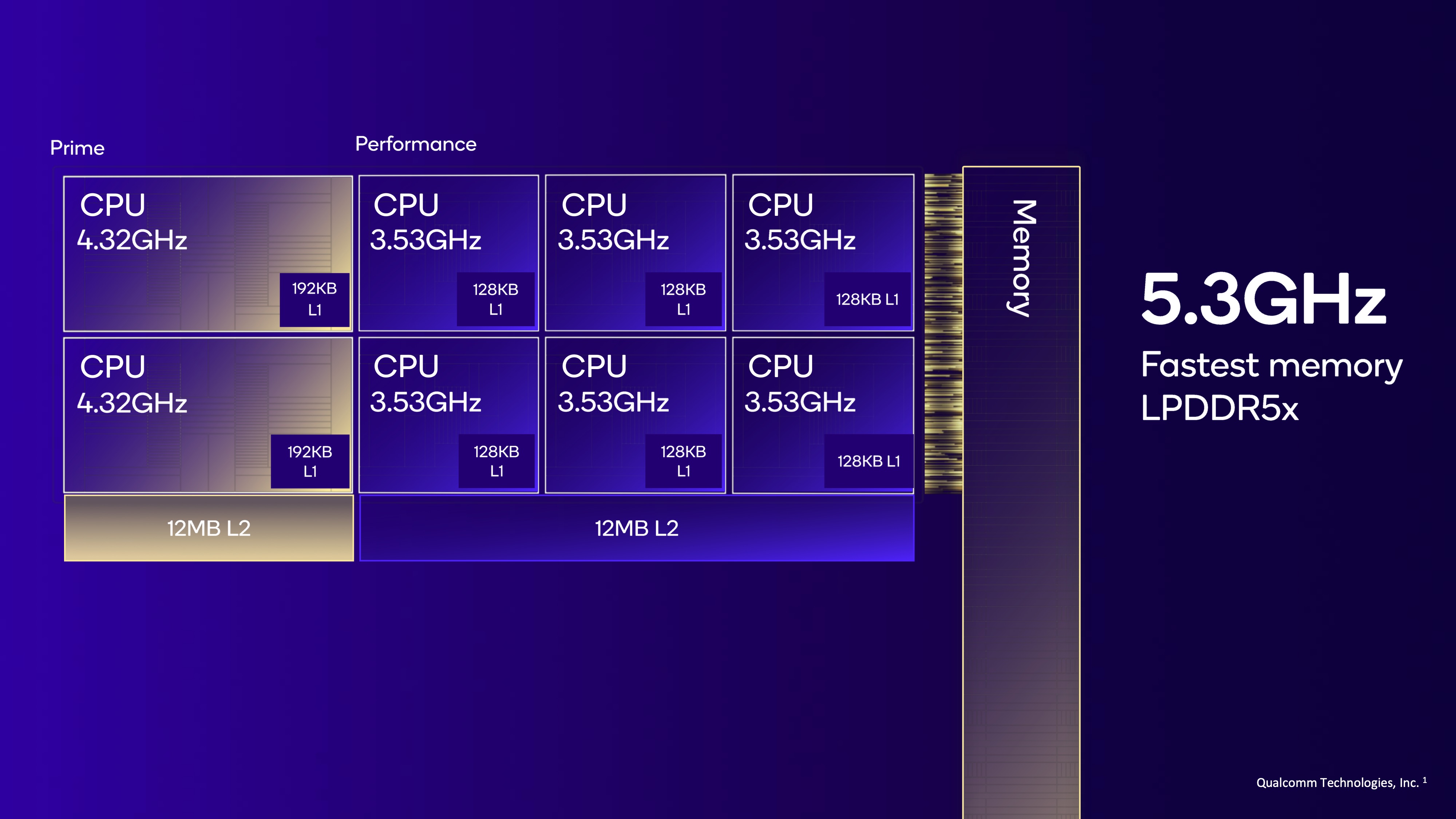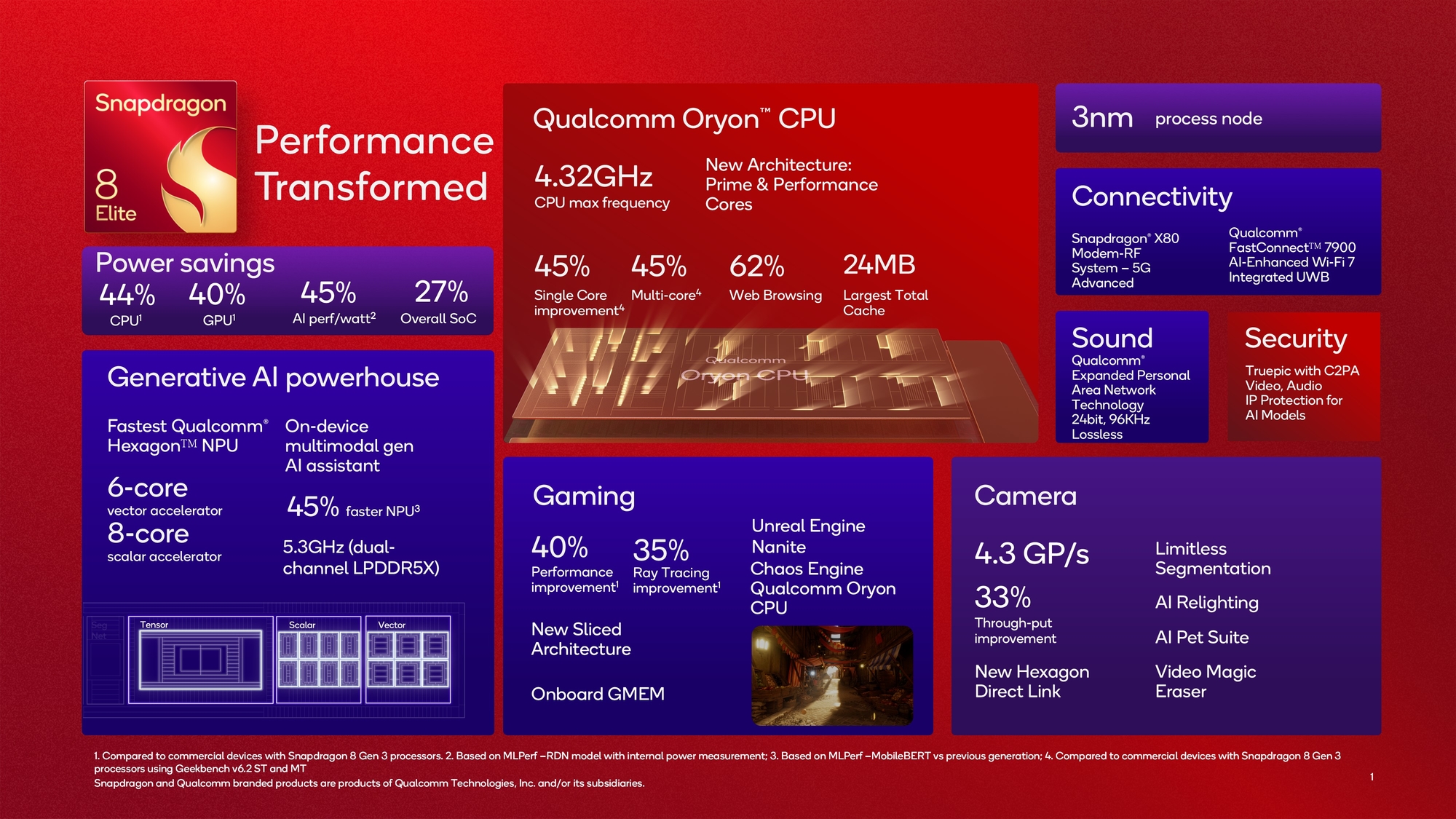What you need to know
- Qualcomm announced the Snapdragon 8 Elite, a 3nm TSMC-made SoC, at its annual summit on Monday.
- It has two 4.32GHz prime cores and six 3.53GHz performance cores, along with 5.3Gbps LPDDR5X memory.
- Qualcomm promises its new Oryon CPU offers a 45% single- and multi-core performance boost with a 44% efficiency boost over the Snapdragon 8 Gen 3.
- Its GPU and NPU performance have also improved by 40% and 45%, respectively.
If you find Qualcomm’s naming scheme for its chips confusing, the Snapdragon 8 Elite is named to make things obvious: This is its fastest system-on-a-chip (SoC) yet, built to make flagship Android phones more powerful than ever.
Announced at the Qualcomm Summit 2024 in Maui, the Snapdragon 8 Elite is the first to use a custom Oryon CPU instead of the usual ARM Cortex cores. Unlike the Snapdragon 8 Gen 3, it won’t have any low-clocked efficiency chips, either: its six performance cores hit 3.53GHz, which is faster than the 3.3GHz Cortex-X4 found in the last-gen SoC. And its two prime cores will hit a blazing 4.32GHz.
As you’d expect, this leads to a 45% boost in single- and multi-core performance over the Snapdragon 8 Gen 3, and it’s 44% more efficient at hitting the same top benchmarks. We’ll have to see how the Snapdragon 8 Elite does for low-power efficiency, but Qualcomm implied during a media session that its performance cores would have no trouble on that front.

Unsurprisingly, Qualcomm emphasizes the Snapdragon 8 Elite’s AI boosts over the last generation as well: a 45% faster NPU and 45% better performance per watt. It’ll enable popular LMMs like Llama and Gemini to integrate “directly” onto phones for speedy multi-modal AI generation.
Qualcomm promises that these AI enhancements will help specifically for better 5G connectivity. The new Snapdragon X80 pairs with the AI Suite Gen 3 that’s meant to improve power handling, coverage, latency, QoS, mmWave beam management, and GNSS location, with a specific 30% location accuracy boost “even in parking structures.”
The Snapdragon 8 Elite jumps to Bluetooth 6.0, which was only announced this September and offers some key upgrades to security and “distance awareness.” And it directly integrates Ultra Wideband for precision finding and digital key tech.
Qualcomm didn’t specify which Adreno GPU will be in the Snapdragon 8 Elite, but it did promise a 40% performance speed boost, 40% power savings, and 35% increased ray tracing performance. It has three GPU slices clocked at 1.1GHz and 12MB graphics memory.

As for other subtle changes, the Snapdragon 8 Elite supports QHD+ resolution up to 240Hz refresh rates, which could offer some incredibly smooth gaming experiences to go with the graphics boost. And we could begin to see 320MP camera sensors for the first time.
Even though everyone assumed the Snapdragon 8 Elite would be called the Snapdragon 8 Gen 4, Qualcomm decided to give it the same “Elite” moniker as the Snapdragon X Elite that it built for PCs.
Aside from saying it “deserves a new name” because of its custom CPU, Qualcomm wouldn’t clarify whether future “Elite” SoCs would keep the “Gen X” label or if non-Elite Snapdragon flagship chips with Arm cores would continue, saying it wouldn’t talk about its future roadmap.

Earlier this month, MediaTek revealed the Dimensity 9400 SoC with one 3.62GHz Cortex core, three 3.3GHz performance cores, and four 2.4GHz efficiency cores, all built on the same TSMC N3E process.
Compared to the Dimensity 9300, its performance gap—35% and 28% faster single- and multi-core performance with 40% better efficiency, plus 41% improved GPU power—isn’t that far off from the gains Qualcomm got with the Snapdragon 8 Elite, even though the clock speeds have a significant gap.
MediaTek says the Dimensity 9400 hit 3,055/9,600 for a Geekbench 6.2 test or 2.8 million for AnTuTu. Qualcomm says the Snapdragon 8 Elite hits 3,222 / 10,444 on Geekbench 6.3 or 3 million for AnTuTu.
Qualcomm wins the benchmark battle, and it does so with its own Oryon cores instead of paying for Arm’s. But you might be surprised that the gap isn’t wider, given just how high the 8 Elite clock speed is. We’ll have to get ahold of phones using both chips and see how they perform in the real world before we can judge for certain.
